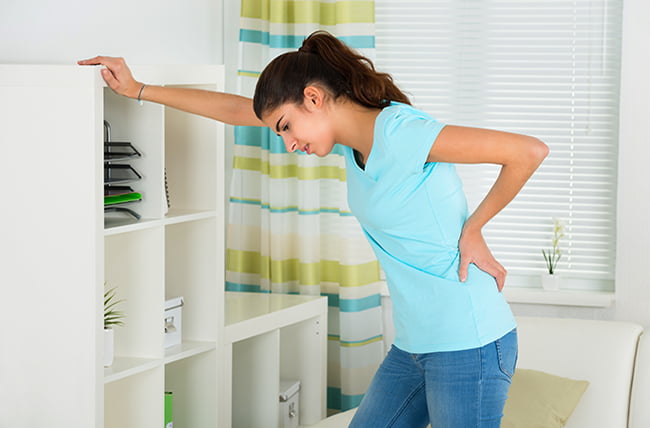Dealing with back pain is an all-too-familiar ordeal for many individuals, and middle back pain on the left side is a specific type that can be particularly discomforting. Whether it appears suddenly or gradually over time, it can disrupt daily activities and affect one’s overall well-being. In this article, we’ll delve into the details of middle back pain on the left side, exploring its causes, symptoms, possible treatments, and preventive measures.
Contents
Understanding Middle Back Pain on the Left Side
Middle back pain, also known as thoracic back pain, occurs in the region between the upper and lower back, namely the area corresponding to the thoracic spine. This section of the spine is more rigid compared to the neck and lower back, making it less susceptible to injury.
However, certain factors can lead to discomfort and pain in this region, and when it’s localized on the left side, it requires specific attention and evaluation.
Common Causes of Middle Back Pain on the Left Side

Middle back pain on the left side can have various causes, ranging from muscle strains to more serious underlying conditions. While I can’t diagnose specific medical conditions, I can provide you with some common causes of middle back pain on the left side:
- Muscle Strain: Overuse, poor posture, or sudden movements can strain the muscles in the middle back, leading to localized pain. This is one of the most common causes of back pain.
- Poor Posture: Sitting or standing with poor posture for extended periods can put excessive stress on the muscles and ligaments in the back, leading to pain.
- Thoracic Herniated Disc: The discs between the vertebrae in the middle back can bulge or herniate, compressing nearby nerves and causing pain.
- Scoliosis: A sideways curvature of the spine can cause uneven pressure on the back, leading to pain on one side.
- Musculoskeletal Conditions: Conditions such as osteoarthritis or osteoporosis can affect the middle back and cause pain.
- Myofascial Pain Syndrome: This condition involves trigger points or knots in the muscles, which can cause referred pain in other areas, including the left side of the middle back.
- Kidney Stones: In some cases, kidney stones can cause referred pain to the middle back on the left side.
- Pancreatitis: Inflammation of the pancreas can lead to middle back pain, often on the left side.
Signs and Symptoms
The signs and symptoms associated with middle back pain on the left side can vary depending on the underlying cause. Here are some common signs and symptoms that may accompany middle back pain:
- Pain: The most obvious symptom is pain in the middle back on the left side. The pain can range from mild to severe and may have aching, sharp, stabbing, or throbbing. It may be constant or intermittent.
- Limited Range of Motion: Depending on the cause of the pain, you may experience difficulty or discomfort when moving your back or twisting your torso.
- Muscle Stiffness: Muscles in the affected area may feel tight and stiff, particularly after waking up in the morning or after prolonged periods of inactivity.
- Muscle Spasms: Some conditions, like muscle strains or myofascial pain syndrome, can lead to muscle spasms in the middle back, causing additional pain and discomfort.
- Radiating Pain: The pain may radiate from the middle back to other areas, such as the left shoulder, left arm, or chest.
- Numbness or Tingling: If a nerve is compressed or irritated, you may experience numbness, tingling, or a pins-and-needles sensation in the left side of your middle back or other parts of the body.
- Weakness: In some cases, you may notice weakness in the muscles of your back or your arms or legs.
When to Seek Medical Attention
Seeking medical attention for middle back pain on the left side is essential, especially in the following situations:
- Severe or Persistent Pain: If the pain is intense and does not improve with rest or over-the-counter pain relievers, it’s important to see a doctor. Severe pain could indicate a more serious underlying condition that requires prompt evaluation and treatment.
- Numbness or Weakness: If you experience numbness, tingling, or weakness in your arms, legs, or other parts of the body along with the back pain, it may suggest nerve involvement. Nerve compression or damage requires medical attention to prevent potential complications.
- Trauma or Injury: If the pain is the result of a fall, accident, or other trauma, it’s crucial to seek medical attention immediately, especially if there is difficulty moving or any other concerning symptoms.
- Fever or Infection: If you have a fever along with back pain, it could indicate an infection or inflammatory condition that requires medical evaluation.
- Difficulty Breathing: If you have trouble breathing or experience chest pain along with middle back pain on the left side, it could be a sign of a more serious condition related to the lungs or heart.
Diagnosis and Evaluation

The diagnosis and evaluation of middle back pain on the left side typically involve a comprehensive approach by a healthcare professional. The process may include the following steps:
Medical History and Physical Examination
When facing middle back pain on the left side, a thorough medical history and physical examination are crucial for accurate diagnosis. The healthcare professional will inquire about the nature of the pain, its duration, and any triggering events. A physical examination may involve testing the range of motion, assessing muscle strength, and examining for signs of inflammation.
Imaging and Diagnostic Tests
To further evaluate the condition, the healthcare provider may order imaging tests, such as X-rays, MRI scans, or CT scans. These diagnostic tools help visualize the structures of the thoracic spine and identify any abnormalities or injuries that could be causing the pain.
Treatment Options
The treatment for middle back pain on the left side depends on the underlying cause of the pain. It’s crucial to get an accurate diagnosis from a healthcare professional before starting any treatment. Here are some common treatment options that may be recommended:
Self-Care and Home Remedies
In mild cases of middle back pain on the left side, self-care measures can often provide relief. Some effective home remedies include:
- Rest: Give your back a break from activities that may worsen the pain, but avoid prolonged bed rest, as it can lead to muscle stiffness and deconditioning.
- Ice or Heat Packs: Applying ice packs in the initial 48 hours after an injury can help reduce inflammation, while heat packs can provide soothing relief to tense muscles after the initial period.
- Gentle Stretching: Perform gentle stretching exercises to improve flexibility and relieve tension in the back muscles. Avoid any movements that cause pain or discomfort.
- Good Posture: Pay attention to your posture, both when sitting and standing. Ensure that your back has proper support, and avoid slouching.
Medications for Pain Relief
There are several medications commonly used for pain relief, including those that can help manage middle back pain on the left side. These medications can be obtained over the counter or may require a prescription from a healthcare professional. It’s essential to follow the recommended dosages and guidelines provided by your doctor or pharmacist. Here are some common types of medications used for pain relief:
- Nonsteroidal Anti-Inflammatory Drugs (NSAIDs): NSAIDs, such as ibuprofen (Advil, Motrin) and naproxen (Aleve), are effective at reducing pain and inflammation. They can be useful for managing mild to moderate back pain caused by muscle strains or inflammation.
- Acetaminophen: Acetaminophen (Tylenol) is an analgesic that can help relieve pain, but it doesn’t have anti-inflammatory properties like NSAIDs. It is generally considered safe when used as directed.
Physical Therapy and Exercise
A physical therapist can design a tailored exercise program to strengthen the muscles supporting the thoracic spine and improve flexibility. Furthermore, this approach can aid in long-term recovery and prevent future occurrences of middle back pain.
Other Alternative Therapies

Always consult with a healthcare professional before trying any alternative therapies, especially if you have a pre-existing medical condition or are taking medications. Here are some alternative therapies that may be considered:
- Massage Therapy: Professional massage can help relax tense muscles, improve circulation, and reduce muscle stiffness and pain.
- Acupuncture: This traditional Chinese practice involves inserting thin needles into specific points on the body to help alleviate pain and promote healing.
- Chiropractic Care: Chiropractors use manual adjustments and manipulations to help realign the spine and reduce pain and discomfort.
Prevention Tips
Incorporating healthy habits into daily life can help prevent middle back pain on the left side. These may include:
- Maintaining Good Posture: Be mindful of your posture while sitting, standing, and lifting heavy objects.
- Regular Exercise: Engage in regular physical activity to keep your back muscles strong and flexible.
- Proper Lifting Technique: When lifting heavy objects, use proper lifting techniques. This is to minimize strain on your back.
- Balanced Diet: A well-balanced diet rich in essential nutrients can support bone and muscle health.
Ergonomic Considerations
Whether at work or home, ensuring ergonomic environments can significantly reduce the risk of developing middle back pain. Invest in ergonomic chairs and desks that support good posture, and make adjustments to computer screens and keyboards to avoid straining the back.
Conclusion
Middle back pain on the left side can be a distressing condition, but with the right understanding and approach, it is manageable. By recognizing the symptoms, adopting healthy lifestyle practices, and seeking appropriate medical guidance, individuals can find relief and pave the way toward recovery. Remember, your back is an essential support system for your body, and taking care of it can lead to a healthier and pain-free life.
Now, armed with this knowledge, you can confidently address middle back pain on the left side, making informed decisions for your well-being. So, start taking proactive steps today, and don’t let back pain hold you back from living your best life!
If you’re experiencing Back pain, physical therapy for back pain at PhysioMantra can help: Book an online physical therapy session.



